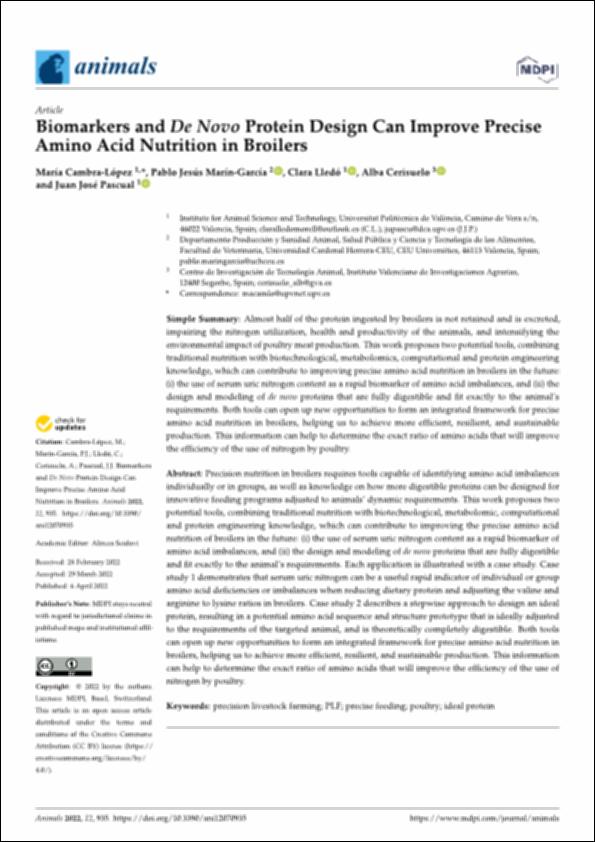Please use this identifier to cite or link to this item:
http://hdl.handle.net/10637/14190Biomarkers and "de novo" protein design can improve precise amino acid nutrition in broilers
| Title: | Biomarkers and "de novo" protein design can improve precise amino acid nutrition in broilers |
| Authors : | Cambra López, María Marín García, Pablo Jesús Lledó Morell, Clara Cerisuelo García, Alba Pascual Amorós, Juan José |
| Keywords: | Proteínas.; Proteins.; Poultry - Feeding and feeds - Biochemical aspects.; Amino acids.; Aves de corral - Alimentación - Aspectos bioquímicos.; Aminoácidos. |
| Publisher: | MDPI |
| Citation: | Cambra-López, M., Marín-García, P. J., Lledó, C., Cerisuelo, A. & Pascual, J. J. (2022). Biomarkers and "de novo" protein design can improve precise amino acid nutrition in broilers. Animals, vol. 12, i. 7 (06 apr.), art. 935. DOI: https://doi.org/10.3390/ani12070935 |
| Abstract: | Precision nutrition in broilers requires tools capable of identifying amino acid imbalances individually or in groups, as well as knowledge on how more digestible proteins can be designed for innovative feeding programs adjusted to animals’ dynamic requirements. This work proposes two potential tools, combining traditional nutrition with biotechnological, metabolomic, computational and protein engineering knowledge, which can contribute to improving the precise amino acid nutrition of broilers in the future: (i) the use of serum uric nitrogen content as a rapid biomarker of amino acid imbalances, and (ii) the design and modeling of de novo proteins that are fully digestible and fit exactly to the animal’s requirements. Each application is illustrated with a case study. Case study 1 demonstrates that serum uric nitrogen can be a useful rapid indicator of individual or group amino acid deficiencies or imbalances when reducing dietary protein and adjusting the valine and arginine to lysine ratios in broilers. Case study 2 describes a stepwise approach to design an ideal protein, resulting in a potential amino acid sequence and structure prototype that is ideally adjusted to the requirements of the targeted animal, and is theoretically completely digestible. Both tools can open up new opportunities to form an integrated framework for precise amino acid nutrition in broilers, helping us to achieve more efficient, resilient, and sustainable production. This information can help to determine the exact ratio of amino acids that will improve the efficiency of the use of nitrogen by poultry. |
| Description: | Este artículo se encuentra disponible en la siguiente URL: https://www.mdpi.com/2076-2615/12/7/935 Este artículo pertenece al número especial "Precision Poultry Farming". |
| URI: | http://hdl.handle.net/10637/14190 |
| Rights : | http://creativecommons.org/licenses/by/4.0/deed.es |
| ISSN: | 2076-2615 (Electrónico) |
| Language: | es |
| Issue Date: | 6-Apr-2022 |
| Center : | Universidad Cardenal Herrera-CEU |
| Appears in Collections: | Dpto. Producción y Sanidad Animal, Salud Pública Veterinaria y Ciencia y Tecnología de los Alimentos |
Items in DSpace are protected by copyright, with all rights reserved, unless otherwise indicated.


